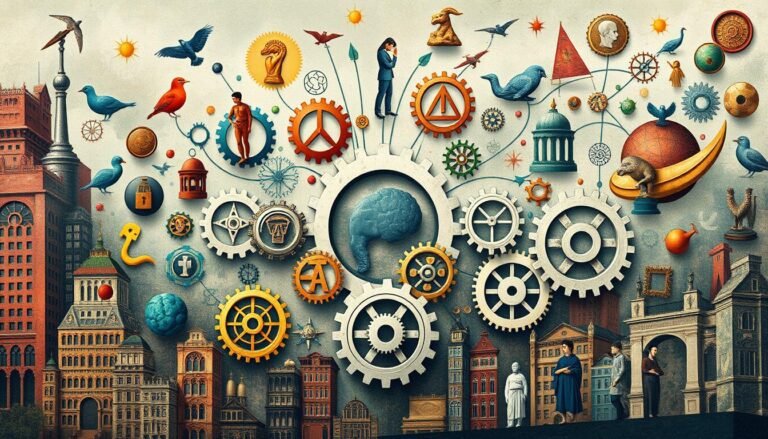Symbolic Interactionism: Understanding Social Interactions
Ever thought about how we make meaning in our daily lives? Symbolic Interactionism gives us a way to look into this. It’s a theory that shows us how we use symbols, language, and gestures to shape our reality.
This theory is all about how we make meaning through social interactions. George Herbert Mead started it in the early 1900s. He said symbols play a big part in how we act and society works. It makes us think about our daily talks and how we understand the world.
Herbert Blumer, a student of Mead, came up with the term “symbolic interactionism.” He built on Mead’s ideas. Blumer believed the self comes from how we interact with others. He saw society as always changing, with meanings being made and remade.
Now, Symbolic Interactionism has grown into three main views: the Chicago School, the Iowa School, and the Indiana School. Each one gives us new ways to think about making meaning in our social lives. For example, Manford Kuhn from the Iowa School used strict science to study social behavior. Sheldon Stryker from the Indiana School looked at how social actions help create social structures.
Key Takeaways
- Symbolic Interactionism explores how we create meaning through social interactions
- George Herbert Mead is considered the founder of this theory
- Herbert Blumer coined the term and further developed the concept
- Three main schools of thought exist: Chicago, Iowa, and Indiana
- The theory emphasizes the role of symbols, language, and gestures in shaping behavior
- It views society as a continuous process of meaning creation
Introduction to Symbolic Interactionism
Symbolic interactionism is a key way to understand how we make meaning in social settings. It shows how symbols, language, and interpretation shape our view of the world.
Definition and Core Principles
Symbolic interactionism has three main ideas. First, we act based on the meanings we give to things. Second, these meanings come from our social interactions. Third, we change these meanings as we go through life.
Historical Development
Symbolic interactionism started in the early 1900s. George Herbert Mead, born in 1863, is seen as its founder. His book, “Mind, Self, and Society,” published in 1934, set the stage for later theories.
Key Theorists and Contributors
Herbert Blumer, a student of Mead, named the theory “symbolic interactionism” in 1937. He built on Mead’s work. Charles Horton Cooley, another key figure, introduced the “looking-glass self” in the 1920s. This idea says our self-image comes from how we think others see us.
“Society is not a structure that stands apart from individuals. It’s what people do together.” – Howard Becker
The University of Chicago Press helped spread symbolic interactionist ideas in the 1960s. Since then, the theory has grown. Processual interactionists in the 1970s-1980s focused on how social interactions change. Today, symbolic interactionism still helps us understand how we interact and navigate our social world.
The Foundations of Symbolic Interactionism
Symbolic interactionism looks at how people make meaning through social interactions. It started in early 20th-century American sociology. It shows how people understand and react to symbols around them.
This theory is all about looking closely at small social actions. It sees how people form their sense of self through everyday talks and actions. It shows that our sense of who we are changes based on our social experiences.
In today’s world, symbolic interactionism has grown. Social media is a great example of how this theory works. Online profiles, digital identities, and emojis help shape our behaviors and views.
“Symbols in everyday life, like those seen in a university graduation ceremony, represent meanings and transitions that are significant to individuals and communities.”
This theory says that reality is what we make of it. It shows how social stigmas start, stay, and can be overcome. It makes social studies more personal by focusing on our own stories and feelings.
| Aspect | Role in Symbolic Interactionism |
|---|---|
| Symbols | Shape human behavior and social interactions |
| Individual Action | Based on meanings assigned to symbols |
| Identity Formation | Influenced by symbols and their interpretations |
| Social Constructs | Race, gender based on subjective interpretations |
Symbolic interactionism gives us a special way to see human behavior. It shows how our interpretations shape our social world. This includes our personal identities and the norms of society.
The Role of Symbols in Social Interaction
Symbols shape our social world, guiding how we act and interact. They range from things we can touch like flags to ideas like freedom. In symbolic interactionism, people act based on the meanings they give to these symbols.
Language as a Symbol System
Language is the main symbol system we use to communicate. Words have meanings that can change based on the culture and situation. For example, the word “freedom” might mean different things to people in different places.
Nonverbal Communication and Gestures
Nonverbal cues are a big part of our symbol systems. A smile, a handshake, or a nod can send messages without words. These gestures often have special meanings in different cultures, making our interactions deeper.
Cultural Symbols and Their Meanings
Cultural symbols have shared meanings in societies. They can be objects, rituals, or ideas that are important to a group. These symbols change over time, showing how society’s values and norms change.
| Symbol Type | Example | Significance |
|---|---|---|
| Language | Words | Primary communication tool |
| Nonverbal | Gestures | Supplement verbal communication |
| Cultural | National flag | Represent shared values and identity |
Understanding these symbol systems helps us see how people interpret and react to their social world. It shows why people from different backgrounds might react differently to the same situation. This highlights the complexity of human interaction.
The Concept of Self in Symbolic Interactionism
Symbolic interactionism focuses on how our sense of self grows through social interactions. It shows how our self-concept changes and affects our identity.
George Herbert Mead believed our self changes through social interactions and seeing ourselves from others’ views. This idea is key to the looking-glass self theory by Charles Horton Cooley.
The looking-glass self theory says we shape our self-concept by guessing how others see us. This process has three main steps:
- Imagining how we look to others
- Understanding how others react to us
- Creating our self-image from these reactions
This constant process of thinking about ourselves and others is key to forming our identity. Through social interactions, we keep changing and refining our self-concept.
| Aspect | Impact on Self-Concept |
|---|---|
| Positive Feedback | Boosts self-esteem and strengthens positive self-view |
| Negative Feedback | Can cause self-doubt and a negative view of oneself |
| Role Identities | Adds structure and organization to our self-concepts |
Remember, our self-concept is not set in stone. It changes as we go through new experiences and meet different people. This ability to change helps us grow and adapt to new social situations.
Symbolic Interactionism: Understanding Social Interactions
Symbolic interactionism looks closely at how we interact with each other. It shows us the power of small moments in shaping our lives. This view stresses the need to study these moments to grasp how we make and understand meanings every day.
Micro-level Focus on Social Interactions
Symbolic interactionism focuses on the details of how we meet face-to-face. It shows how we shape our social lives through these meetings. By looking closely at our daily talks, it uncovers the complex ways we communicate and behave socially.
Interpreting and Negotiating Meanings
At the heart of symbolic interactionism is the idea of negotiating meanings. We don’t just take in meanings; we also change them based on what we’ve learned. This process is key to how we see the world and how we interact with others.
The Impact of Social Interactions on Behavior
Social interactions greatly shape how we act. Through these meetings, we learn and adjust our understanding of what’s expected of us. This constant process of making sense and adjusting is central to symbolic interactionism.
| Aspect | Focus | Impact |
|---|---|---|
| Micro-level Analysis | Face-to-face interactions | Reveals patterns in communication |
| Meaning Negotiation | Active interpretation of symbols | Shapes social reality |
| Social Behavior | Adaptation to social norms | Influences individual actions |
By looking at these small interactions, symbolic interactionism gives us deep insights into human behavior. It shows us how we build, keep, and change our social worlds through everyday meetings.
The Process of Meaning-Making in Social Contexts
Symbolic interactionism shows us how we make meaning through social interactions. It says that reality is built together, with meanings coming from our daily talks and actions. In this, how we understand symbols and actions is key, shaped by our social lives.
Our view of the world changes all the time. What symbols mean to us, like words or gestures, comes from our social experiences. This way of making meaning is what builds our shared reality.
Think about language, a key way we talk to each other, and how it means different things in different places. A simple thumbs-up can mean yes in one place but no in another. This shows how important it is to share meanings in groups.
“Reality is not a fixed state but a fluid process, constantly being negotiated and renegotiated through our interactions with others.”
In our daily lives, we have many interactions that help us understand the world. From chatting with friends to meetings at work, each talk adds to how we make meaning together. This shows how social life is always changing and how our interactions shape what we see.
Role-Taking and Identity Formation
Role-taking and identity formation are important in symbolic interactionism. They help us understand how we see ourselves and interact with others. Let’s look at the looking-glass self theory, multiple roles, and social expectations.
The Looking-Glass Self Theory
The looking-glass self theory explains how we form our self-image. We imagine how others see us and adjust our behavior. This process shapes our identity. For instance, if we think others see us as kind, we might act more kindly.
Multiple Roles and Identity Negotiation
We all have multiple roles in life. You might be a student, friend, and employee. Each role has its own social expectations. Balancing these roles is part of negotiating our identity. It’s about finding who we are in different situations.
Social Roles and Expectations
Social expectations shape our behavior in different roles. These expectations can change based on culture and context. For example, what it means to be a “good student” might differ between countries. Understanding these expectations is key for successful role-taking.
| Aspect | Impact on Identity |
|---|---|
| Role-Taking | Increases empathy and social skills |
| Multiple Roles | Leads to complex, layered identities |
| Social Expectations | Guides behavior in different contexts |
Understanding role-taking and identity formation helps us navigate social interactions. It shows how we shape our identities through our roles and relationships with others. This knowledge can improve our social skills and self-awareness.
Symbolic Interactionism in Everyday Life
Symbolic interactionism shapes how we interact and behave every day. It helps us see how people follow social norms and understand others’ actions. Symbols are key in our social lives, from family to work.
- Flags bring out strong feelings of patriotism, showing symbols can bring people together or tear them apart.
- Gender roles are shaped by how we interact with others, affecting what we see as masculine or feminine.
- Emojis are a new way to express ourselves, but their meanings change with age and culture.
- Memes are like inside jokes, needing knowledge of certain references to get them.
The “Looking Glass Self” idea shows how our view of ourselves comes from how we think others see us. Charles H. Cooley came up with this idea. It has three parts:
- Thinking about how we look to others
- Understanding how others react to us
- Building our self-image from these reactions
Knowing about symbolic interactionism helps us deal with social situations better. It shows the strength of symbols and how they shape our lives. This understanding helps us get along with others and know ourselves better.
Applications of Symbolic Interactionism in Research
Symbolic interactionism gives a special view on social research. It looks closely at how people make and understand meanings every day. Researchers use different tools to explore these complex interactions.
Qualitative Research Methods
Qualitative research is key in symbolic interactionism studies. Researchers use in-depth interviews and watching people to get detailed data. These methods show how people give meaning to symbols and actions in their lives.
Dramaturgical Analysis
Erving Goffman’s dramaturgical analysis sees social life as like a play. It looks at how people act in different situations, like actors on stage. This method helps us understand the roles we take on in our daily lives.
Case Studies and Ethnographic Approaches
Ethnography lets researchers live among the people they study. By doing this, they get to see how meanings are made and shared. Case studies then take a closer look at specific situations. They reveal the complex interactions that shape our social world.
Source Links
- Symbolic Interactionism Theory & Examples
- Symbolic Interactionist Theory | Introduction to Sociology
- What is Symbolic Interaction Theory? — Delve
- Symbolic Interaction Theory
- Understanding Symbolic Interactionism in Sociology
- What is Symbolic Interactionism Theory? | Background & Uses
- Understanding Symbols in Symbolic Interactionism
- What Is Symbolic Interactionism?
- Symbolic Interactionism
- Symbolic Interactionism – Self-concept Formation
- The Symbolic Interactionist Concept of Self-Concept in Sociology
- Understanding Self-Concept through Symbolic Interactionism
- Symbolic interactionism
- Reading: Symbolic Interactionist Theory | Sociology
- Symbolic Interactionism (Concepts & Beliefs)
- Symbolic interactionism – Vocab, Definition, and Must Know Facts | Fiveable
- The Symbolic Interactionist View of Identity in Sociology
- Exploring the Symbolic Interactionist Concept of Role Taking in Sociology
- Symbolic Interactionism: Understanding Human Behavior Through Symbols
- 10 Symbolic Interactionism Examples (And Easy Definition)
- Symbolic Interactionism: Theory & Examples
- What Is Symbolic Interaction Theory?







